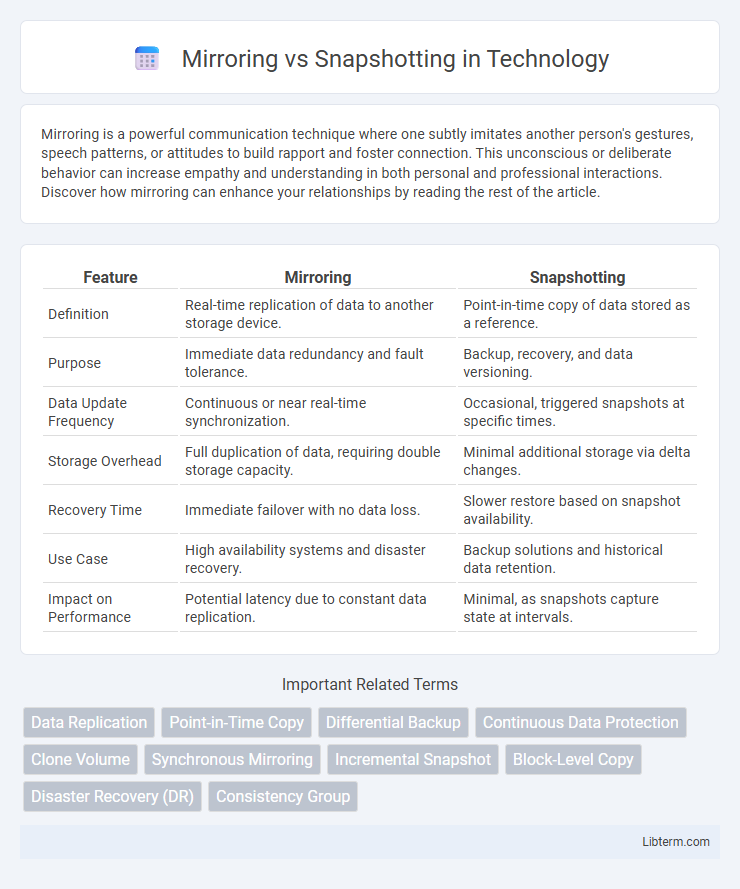Mirroring is a powerful communication technique where one subtly imitates another person's gestures, speech patterns, or attitudes to build rapport and foster connection. This unconscious or deliberate behavior can increase empathy and understanding in both personal and professional interactions. Discover how mirroring can enhance your relationships by reading the rest of the article.
Table of Comparison
| Feature | Mirroring | Snapshotting |
|---|---|---|
| Definition | Real-time replication of data to another storage device. | Point-in-time copy of data stored as a reference. |
| Purpose | Immediate data redundancy and fault tolerance. | Backup, recovery, and data versioning. |
| Data Update Frequency | Continuous or near real-time synchronization. | Occasional, triggered snapshots at specific times. |
| Storage Overhead | Full duplication of data, requiring double storage capacity. | Minimal additional storage via delta changes. |
| Recovery Time | Immediate failover with no data loss. | Slower restore based on snapshot availability. |
| Use Case | High availability systems and disaster recovery. | Backup solutions and historical data retention. |
| Impact on Performance | Potential latency due to constant data replication. | Minimal, as snapshots capture state at intervals. |
Introduction to Mirroring and Snapshotting
Mirroring involves creating an exact real-time copy of data to another storage location, ensuring high availability and fault tolerance. Snapshotting captures the state of a system or data at a specific point in time, allowing rapid recovery and data versioning without duplicating the entire data set. Both techniques are essential for data protection, with mirroring emphasizing continuous replication and snapshotting focusing on point-in-time data preservation.
Key Differences Between Mirroring and Snapshotting
Mirroring creates an exact, real-time copy of data, ensuring continuous data availability and redundancy, while snapshotting captures the state of data at a specific point in time, enabling quick recovery without duplicating entire datasets. Mirroring requires more storage and bandwidth as it duplicates ongoing changes, whereas snapshotting uses less storage by only recording differences since the last snapshot. Key differences center on real-time replication versus point-in-time recovery, resource usage, and their roles in backup strategies.
How Mirroring Works in Data Management
Mirroring in data management creates an exact, real-time replica of data across multiple storage devices, ensuring high availability and fault tolerance. This process continuously duplicates each write operation from the primary storage to the mirror, minimizing data loss during hardware failures. By maintaining synchronized copies, mirroring supports seamless data recovery and load balancing in enterprise systems.
The Mechanics of Snapshotting
Snapshotting involves capturing the entire state of a dataset at a specific point in time by recording metadata pointers to data blocks rather than duplicating the data itself, enabling efficient storage and quick recovery. This mechanism allows systems to create consistent and instantaneous copies without disrupting ongoing operations, as only changed data blocks are copied during subsequent snapshots (copy-on-write). The use of metadata mapping and copy-on-write techniques distinguishes snapshotting from data mirroring, which continuously duplicates data for real-time redundancy.
Use Cases for Mirroring Solutions
Mirroring solutions are essential for real-time data replication, providing continuous availability and disaster recovery by creating exact copies of data across multiple locations. They are widely used in mission-critical systems such as financial services, healthcare, and e-commerce platforms where data integrity and zero downtime are paramount. Organizations leverage mirroring to ensure seamless failover capabilities and maintain business continuity during hardware failures or cyberattacks.
Use Cases for Snapshotting Solutions
Snapshotting solutions are ideal for backup and disaster recovery scenarios, enabling quick restoration of data to a specific point in time without impacting ongoing operations. They support versioning and incremental backups, allowing organizations to efficiently manage data changes and protect against accidental deletions or ransomware attacks. Enterprises utilize snapshotting for development and testing environments to create isolated copies of production data, speeding up deployment and troubleshooting processes.
Performance Impact: Mirroring vs Snapshotting
Mirroring continuously duplicates data in real-time, leading to consistent write performance overhead but minimal read latency impact, making it suitable for high-availability systems requiring immediate failover. Snapshotting captures point-in-time copies without duplicating data constantly, resulting in lower write performance impact but potential read latency increases during snapshot creation or consolidation phases. The choice between mirroring and snapshotting hinges on balancing real-time data redundancy with system performance demands, where mirroring favors immediate data protection and snapshotting supports efficient long-term storage and backups.
Data Security and Recovery Considerations
Mirroring provides real-time data replication ensuring immediate recovery and minimal data loss during hardware failure, enhancing data security through continuous backup. Snapshotting captures point-in-time images of data, enabling quick recovery from accidental deletions or corruption without impacting system performance. Combining both methods improves overall data resilience, balancing instant failover with historical recovery options.
Cost Implications of Mirroring and Snapshotting
Mirroring incurs higher storage costs due to continuous data duplication, requiring double the space for real-time redundancy and increased network bandwidth for synchronous replication. Snapshotting reduces costs by capturing only incremental changes at specific intervals, significantly lowering storage consumption and minimizing performance impact on primary systems. Organizations must weigh mirroring's higher upfront and operational expenses against snapshotting's cost-efficient data protection with potential recovery time trade-offs.
Choosing the Right Solution for Your Needs
Mirroring provides real-time data replication, ideal for environments requiring immediate disaster recovery and high availability, while snapshotting offers point-in-time data copies useful for backup and rollback purposes. Evaluate your system's recovery time objectives (RTO) and recovery point objectives (RPO) to determine if continuous data protection (mirroring) or periodic data capture (snapshotting) better aligns with operational needs. Consider factors such as storage capacity, performance impact, and data change frequency when selecting the appropriate data protection strategy.
Mirroring Infographic

 libterm.com
libterm.com